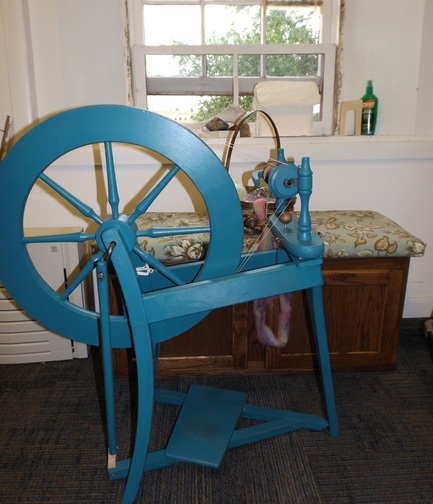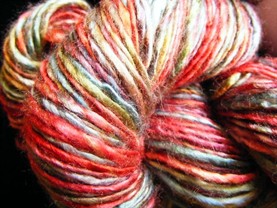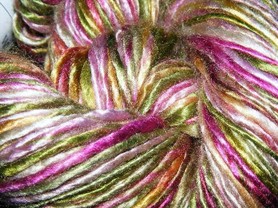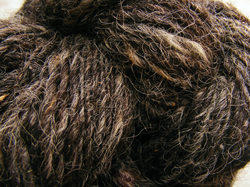It's a gloomy trying to rain day in Wyoming and I've been dyeing Lincoln wool and a superwash Columbia Rambouillet wool roving. I've been doing this for years and the process is pretty automatic to me. Clean wool, stuff in canning jars, make dye, add dye, heat set, let cool, dry, spin. Today I looked at the curly Lincoln wool and squished roviing in the jars and noticed something- the play of color and texture is actually very intriguing. So much, that I took the pictures you see below. Maybe I should pay attention more often.
 Welcome back! Well, at least to me. I’ve been slacking. Okay, that’s not completely true. I have been spinning lots of yarn, dyeing lots of wool, and knitting a sweater (the Terra Linda Cardigan if you’re interested.) Last month I also was gifted a spinning wheel, my third one. She’s an Ashford Traditional, first purchased by the original owner in 1976. She was originally dark walnut, but I painted her teal and she’s used for demonstrations sometimes. Her color, incidentally for those who are fans of Daryl’s Restoration Over Hall on DIY network, is the same as the reproduction historic sink in the new kitchen. She’s supposed to represent something from the 1800s and I spend a lot of time explaining that the color is, yes, historically correct. It's a bit darker than pictured. I also spend a lot of time explaining the theory of spinning yarn- the how to's and different types of wool. One family found out I can ramble if you let me. Her name is Charlotte. If you’re wondering, and if you’re not, the dark walnut bench behind it was something that I built from a kitchen cabinet I got from Menards. I needed something to #1- store wool, and #2, be the right height to sit and spin. I find around 17 inches tall is the right height for me. At some point I will give a thorough review. And at some point I will give a history lesson on historic painted spinning wheels. Actually, I’ll do that right now. I’ve been researching spinning wheels lately- forms, styles, and colors. While a vast majority of wheels are natural wood colors, I have found two colors that predominate when they are painted- shades of medium-dark blues and greens. I found one with burgundy trim. Since I can ramble on about anything spinning related I will stop now. See you soon!  Okay, the above title is a half truth. It’s a sort of favorite spinning fiber and it’s supposed to be called bamboo….. rayon. Eek! Why? Because rayon is a regenerated cellulose process, and in the case of bamboo rayon, bamboo stalks are the cellulose fiber. Bamboo comes in two spinning fiber forms, one is transformed chemically into a spinning fiber, the other mechanically. Bamboo rayon which I’ll talk about now is the chemically transformed one, and bast bamboo, which I will talk about in a later post, is the mechanically transformed one. I have a love, maybe love, I really don’t love this fiber type of relationship. Things I love: It’s incredibly soft and has a beautiful luster. Look at the pictures below, the shine is just gorgeous. It also dyes relatively easily (I use Dharma Trading dye for plant fibers) and, I’ll say it again, beautifully. Yes, bamboo is a renewable resource. I grew up where there were lots of bamboo groves, and it grows and grows and grows. It’s soft on the hands to spin. The resulting yarn has a wonderful drape and great stitch definition if knitted. Things I don’t: It’s very fine and gets on clothes, furniture, the carpet, while spinning. I find it staticy so when I’m pulling the roving into thinner slivers to spin I have the static halo, which has fibers sticking to everything close to it, like my hands. It’s made by a chemical process where the bamboo is dissolved into a slurry with chemicals and fed through a machine that makes the fibers. The grass is natural, the fiber is manmade, which is why the correct classification is bamboo rayon. It’s obviously not the only fiber like this- tencel can also be called wood rayon, because it’s made from trees in a similar process. ( I will talk about tencel in a later post. ) Drafting take some getting used to because the fiber can be at the same time slippery and clingy- all that shine equals slip, but the very fine fibers don’t want to draft (i.e. pull apart) sometimes. I find it easier to either spin in small slivers of roving about ¼ inch wide, or predraft the roving if I’ve only slivered into widths of ½ inch. Now, once I’ve spun about 100 yards, I still hate the staticy fiber that gets everywhere but I stand up and look at my bobbin and admire the lovely yarn and keep spinning. When I’m done I get out the sticky roller and clean up all the errant fibers.  Things in the middle: It’s a silk alternative, meant to be readily available and cheaper than silk. I’ve seen it been called bamboo silk, which, okay, it’similar to the luster and feel of silk (spun that too, will write about at some point), but it’s not silk. Silk is a natural fiber from moths, this is a chemically processed grass, a beautiful one, but not completely natural as it’s been endlessly touted. Don’t get me wrong, I still like bamboo rayon but I have issue with the chemicals used in the process. Most, if not all of it, is made in China, and I have read their process is getting more environmentally friendly. I don’t want to say I won’t spin it every again because I still love the results. Bast bamboo fiber review coming at a later time. Below is, as usual, some of my handdyed and handspun bamboo rayon yarns.  We need to start here, specifically how a Spaniard sheep got to New Mexico: Navajo churro sheep are descendants of the Iberian Churra sheep, brought to the Rio Grande Valley (i.e. New Mexico) in 1598 as Spain was establishing villages in this new area (at least to them). The initial number brought with Don Juan Onate and his settlers was 2900 sheep. The Spanish enslaved the Pueblo people and had them work as shepherds and weavers, the Navajo acquired sheep through trade and raiding. In 1680, the Pueblo people revolted and threw out the Spanish, but they didn’t take their sheep. The Navajo acquired more sheep and expanded the flocks for food, but more importantly for this story, for their wool. These sheep remained in isolated flocks throughout the area that would become New Mexico and Arizona with the Navajo and Pueblo peoples. In an attempt to get Navajo lands for Western settlers, the US government ordered the destruction of Navajo orchards, but also their sheep. This military action culminated with the Navajo Long Walk, where they were forced to march 300 miles to Bosque Redondo, New Mexico. As with the Cherokee Trail of Tears, many didn’t make it. After 3 years, the Navajo were allowed to return to their ancestral land and families were issued “native sheep” from flocks that were from New Mexican villages. The last hurdle the sheep and the Navajo had to endure was a 1930s program to eradicate some of the livestock on the Navajo reservation due to a severe drought. By this time the flock which had grown to over ½ million was reduced by about 30%. The Navajo said they knew how to manage their stock of sheep, goats, and horses on their land as they had for hundreds of years and this was unnecessary. By the 1970s, the Navajo Churro was critically endangered at around 500 head. Several conservancies stepped in and slowly the sheep breed has been revitalized, although still in low numbers compared to many other sheep breeds, but it is no longer facing extinction. Churro sheep are double coated, with a long straight coarse top coat and a softer, shorter inner coat. The staple length is 6-12 inches for the outer coat, and 3-5 for the inner coat. Many have horns, some with four or more. They are well suited to the harsh environment of the desert Southwest of cold night, hot days, and little water. They come is all colors of brown, black, white, and pretty much any color in between. It’s supposed to be a no- luster wool but I have seen a few fleeces with a pearlescent sheen to them. I’ve got my hands on several fleeces and mini mill produced roving over the past years. All but one have been from New Mexico, the stray one was from a farm in Montana. Most have been dark brown, grays, and black. I’ve also spun some oatmeal color roving before. I also have one gorgeous white fleece I’m hanging onto for a spinning/natural dyeing project. I’ve got fleeces with really coarse outercoats and some where the outercoat was almost as fine as the innercoat. I don’t separate the coats, I just fluff and spin, however I’ve found that is the outercoat is really coarse it is actually easier to separate the two. You hold each end of the fleece and pull apart. In general, Navajo churro is not next to skin soft. Lamb fleeces are the exception. However, you need to remember the breed’s wool was used for weaving hardwearing objects such as saddle blankets and rugs, which the wool’s coarseness is perfectly suited for. Below is some of my Navajo churro handspun yarns. All but one are natural colored. |
AuthorYarn artisan, Spinning Gypsy, lover of all sorts of textile arts Archives
September 2014
Categories
All
|

 RSS Feed
RSS Feed
